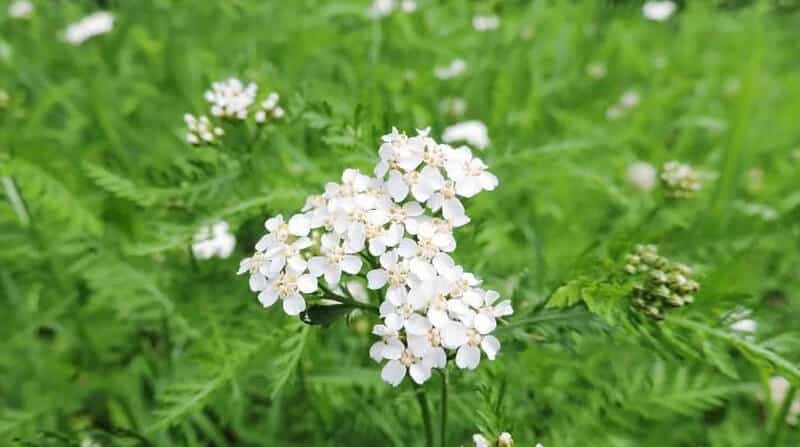Yarrow weed, or Achillea millifolium is also known as Milfoil.
In fact, like Woodrush and other weeds, Yarrow weed in the lawn can be a sign that your lawn is poor health.
It can also be pretty resistant to selective weed killers which can make getting rid of it a challenge.
But in this article, I’m going to show you how I’d remove it and prevent it from growing back.
Yarrow Weed in a Nutshell
Before we can treat Yarrow effectively, it’s worth knowing a bit about it.
Appearance
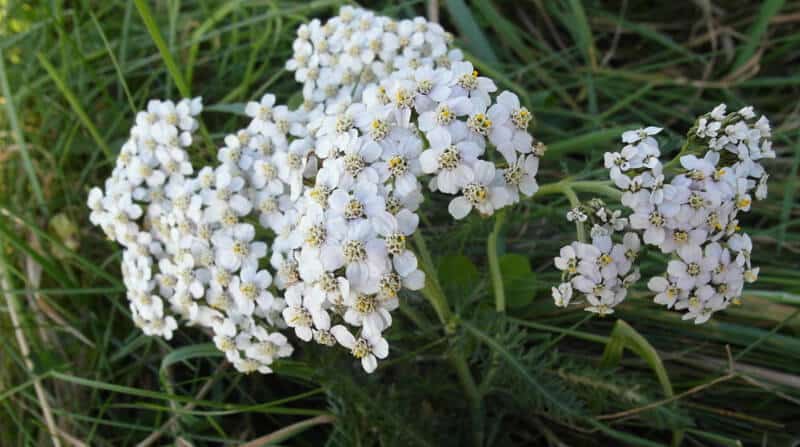
Yarrow is an invasive weed that forms mats of ferny green foliage. It grows from Rhizome stems which grow below the surface of the soil, rooting at intervals.
The roots are tough and fibrous which makes this weed very tolerant to drought.
Although you won’t see them if you mow your lawn, the Daisy-like flowers are borne on stems between June and August and form a flat-topped cluster.
A Perennial Weed
Achillea Millifolium is an aggressive perennial weed, meaning that if not checked, the same weed can live for years.
Preferred Habitat
Yarrow will quite happily grow in all types of soil but it loves dry, chalky soils that are deficient in plant nutrients. In conditions like these, it can grow at an alarming rate, outcompeting the grass.
How to Remove Yarrow Weed From Your Lawn
Like I said earlier, Yarrow weed can be difficult to remove and control but this is how I’d do it;
Dig Out Any Clumps
Yarrow is very tolerant to selective weedkillers so before you waste your money, dig out any plants with a trowel or hand fork. It often helps to rake the weeds first with a springbok rake so you can get a hold of them.
Make sure you remove as much of the roots as possible as it can regrow from root fragments left in the soil.
If your lawn is covered, this might take a while but you’ll need to persevere.
Spray a Weedkiller Concentrate Over the Whole Lawn
If you’ve been thorough then hopefully there won’t be many plants left. However, if you have weeds grow back in your lawn, treat the whole lawn with a weedkiller concentrate.
I recommend Weedol Lawn Weedkiller Concentrate which is designed to be diluted with water and applied with a watering can or knapsack sprayer.
Be sure to dilute the concentrate accurately though. You might be tempted to make it stronger than the instructions recommend but you’ll risk killing the grass. Dilute it too much though and it might not be strong enough to kill the weeds.
So make sure you read the instructions!
- Apply through a sprayer or watering can
- Non-glyphosate formulation
Kill it with a Selective Spot Spray Weed Killer
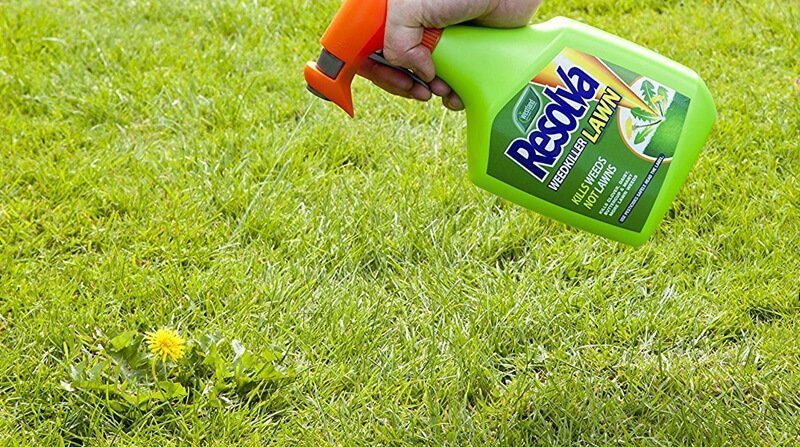
If you treat the lawn with Weedol Concentrate then hopefully this will do the trick. In reality, it’ll probably resist it.
In which case you can either try digging it out again or give it a further treatment 6 weeks later with Resolva Spot Spray Weedkiller for Lawns.
- Small spray bottle ideal for small areas
- Non-glyphosate formulation
Weedol and Resolva can only be applied once a year so if you treat your lawn with Weedol the first time around, you shouldn’t use it again for a year. The same goes for Resolva.
However, they’re different products with different active ingredients and go about killing weeds slightly differently. So it’s perfectly safe to use them in conjunction with each other.
This will also give you a much better chance of killing the weed once and for all.
Read: The Best Weed Killer For Lawns
How to Prevent Yarrow From Growing in Your Lawn
As I have already mentioned, Yarrow weed thrives in dry, nutrient-deficient soil. So in order to prevent it from growing in your lawn, you should make changes to improve the soil.
The following lawn treatment plan will also help.
Scarify Your Lawn to Reduce Thatch
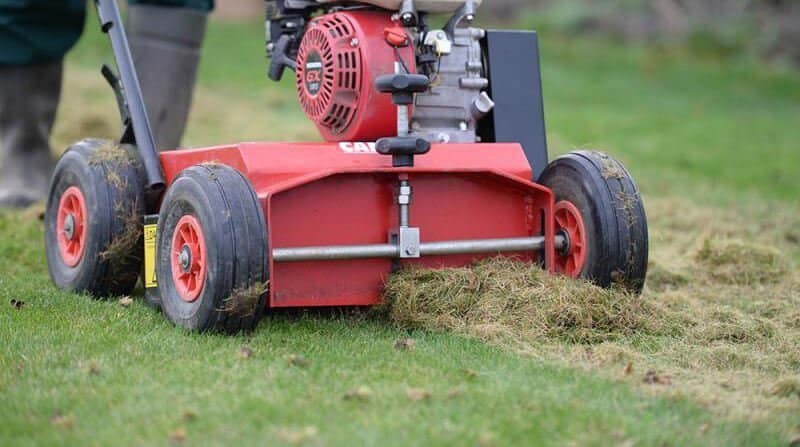
Thatch is a fibrous layer of organic matter that lies just under the grass but on top of the soil. It’s made up both living and dead grass roots and other matter.
Some thatch is good because it prevents the lawn from becoming diseased. Too much though, and it stops air, water and nutrients from getting into the soil. In turn, the soil becomes deficient in nutrients, water and oxygen so the grass doesn’t grow very well.
This creates the perfect environment for Yarrow to inhabit.
Scarifying your lawn will reduce lawn thatch and open the soil so these vital nutrients can penetrate the soil, giving the grass what it needs to produce food and grow.
Read: Why You Should Scarify Your Lawn and How to Do It
Also Read: What Type of Scarifier Should I Use? How to Choose the Best One For the Job
Aerate Your Lawn to Relieve Soil Compaction
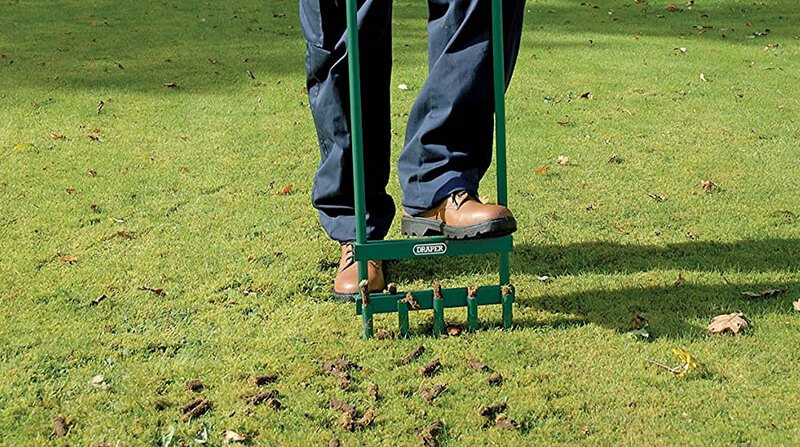
Soil compaction happens when kids or pets play on the lawn if you walk up and down the same area of your lawn while hanging out the washing, or when the postman takes the same route over your lawn to get to the letterbox.
Over time the forces that go through the lawn push the soil particles together, squeezing out air and water. The ground becomes hard too.
When the soil is so hard and compact, air, water and nutrients can’t penetrate it. This means the grass doesn’t have access to the nutrients it needs to grow, resulting in patches of threadbare grass.
To relieve compaction, spike your lawn in the spring with either a garden fork or a pair of aeration shoes. Then, hollow-tine your lawn in the autumn to remove cores of turf and soil.
This will allow your lawn to breathe and let water and nutrients penetrate the soil, giving the grass what it needs to produce food and grow strong.
Read: The Ultimate Guide to Lawn Aeration: Why, When and How to Do It
Fertilise Your Lawn
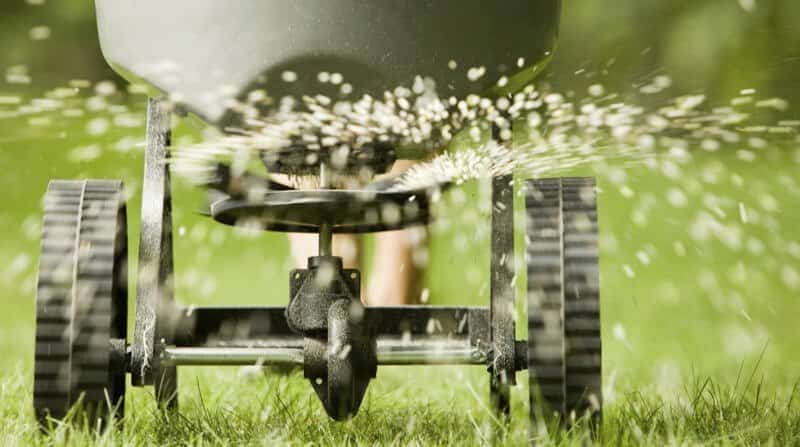
Yarrow thrives in nutrient deficient soil, so, fertilising your soil will prevent it from growing and give the grass what it needs to grow strong.
Nitrogen, Potassium and Phosphorous are critical for grass growth and strength. Apply a good quality fertiliser after scarifying and aerating.
There’s no point doing it before as it won’t be able to get into the soil and you’ll see no benefit.
There are many types of fertilisers available that can be used at different times of the year.
If you’re not particularly green-fingered though, apply a slow-release fertiliser just once a year. Your lawn will look much better for it.
Read: Everything You Need to Know About Fertilising Your Lawn
Also Read: The Best Lawn Feed and Weedkiller: My Recommendations
Mow the Lawn Regularly

One of the secrets and most important part of maintaining and healthy, weed free lawn is to cut the grass regularly.
Regular mowing keeps the height of the grass relatively low. When it is prevented from growing upwards, it adapts and grows sideways producing new shoots and new leaves. All this results in lush, thick grass.
Cutting your grass much more than walking up and down the lawn once a fortnight though. There’s more to it than that, especially if you want a lawn to be proud of.
Read: How to Mow the Lawn Like a Pro
Now it’s Your Turn
Removing Yarrow weed can be a challenge so ready yourself for battle. It can take a while a while to completely get rid of it so you’ll need to equip yourself with plenty of patience.
But killing weeds is only have the battle, preventing them from growing in the first place is where the work is.
That said, it’s not hard work. It just takes a little bit of knowledge and the commitment to apply it.
- Scarify once every couple of years to keep lawn thatch under control,
- Aerate compacted areas in spring and autumn
- Fertilise at least once a year
- Cut the grass regularly
That’s all there is to it.
You’ll be amazed at the difference you see in your lawn.
Speaking of which, if you’re on a mission to rid your lawn of its weeds, take a before and after picture and send it in. I’d love to see them and share them with our community.
And as always, if you have any comments, questions or suggestions, leave a comment below.
